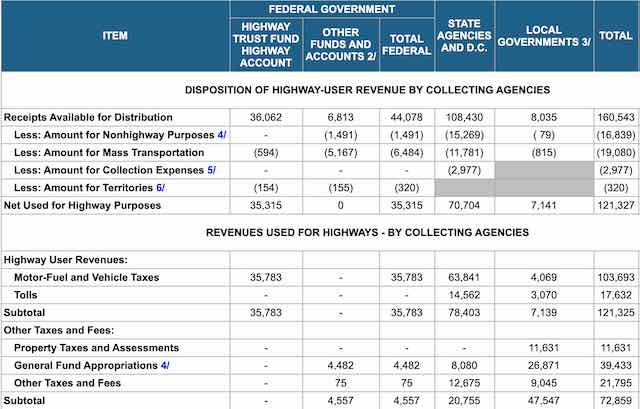
Highway subsidies in 2018 totaled to $47.1 billion, substantially less than the $54.3 billion in subsidies received by transit agencies. Considering that highways move about 100 times as many passenger miles (and infinitely more freight) than transit, this is a serious disparity.
I base the $47.1 billion on the latest issue of Highway Statistics, table HF-10, which was recently posted by the Federal Highway Administration. Although this table is dated April, 2020, it wasn’t available in June when I most recently calculated transportation subsidies.
Click the image above to download the table in Excel format.
I calculate subsidies by adding all non-user fees spent on roads and subtracting diversions of user fees to non-road programs such as transit. Titled “Funding for Highways and Disposition of Highway User Revenues,” table HF-10 both of these amounts for federal, state, and local governments.
The diversions can be found in cells O16, “amount for nonhighway purposes,” and O17, “amount for mass transportation.” In 2018, they totaled to $35.9 billion, which is probably a record. That’s out of a total of $157.5 billon in revenues (after deduction of collection expenses), so more than a quarter of user fees were spent on non-highway programs.
Most of the non-user fees spent on highways are shown in cell O32, the total of “other taxes and fees,” including property taxes, general fund appropriations, and other taxes. In 2018, this was $72.9 billion. However, that leaves out one important number.
Back in 2015, Congress passed the most recent surface transportation bill which called for spending more money on roads than the highway trust fund was collecting. To keep the trust fund from going broke, it appropriated $70 billion in general funds to be spread over five years. This can be seen in the lines for 2016 in table FE-210, “Status of the Highway Trust Fund.”
Of this amount, $50,908,440,000 went for highways. To account for this, I divided this number by five and added it to the highway subsidies, bring them to a total of $83.0 billion. Subtracting the $35.9 billion results in a net subsidy of $47.1 billion.
According to table VM-1, highways carried 5.565 trillion passenger-miles of travel in 2018. This includes 144 billion attributed to the drivers of heavy trucks, but drivers aren’t passengers so I don’t count them. I’m also suspicious that the 388 billion attributed to buses is about three times too high. Making these corrections reduces actual highway passenger miles to about 5.16 trillion.
Read the rest of this piece on The Antiplanner.
Randal O'Toole (rot@ti.org) is a Cato Institute Senior Fellow working on urban growth, public land, and transportation issues. He is the author of numerous Cato papers and has also written for numerous other national journals and newspapers.
Photo credit: Cacophony via Wikimedia under CC 3.0 License.













